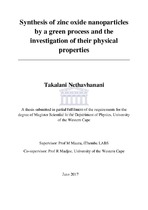Synthesis of zinc oxide nanoparticles by a green process and the investigation of their physical properties
Abstract
Zinc oxide (ZnO) is a wide and direct semiconductor with a wurtzite crystal structure. Its
multifunctionality as the ideal candidate in applications such as blue-UV light emitting
diodes, transparent conducting oxide, selective gas sensor and efficient catalyst support
among others, has attracted a significant interest worldwide. Nano-scaled ZnO has been
synthesized in a plethora of shapes. A rich variety of physical and chemical methodologies
have been used in the synthesis of undoped or doped ZnO. However, such methods either
necessitate relatively high vacuum infrastructures, elevated temperatures, or the use of toxic
reagents. The "green chemistry" synthesis of metal oxide nanoparticles which is based on
using natural plant extract as an effective 'reducing agent' of metal precursor, has been
reported to be a cleaner and environment-friendly alternative to the physical and chemical
methods. The thesis is based on the synthesis and the main physical properties of pure ZnO
nanoparticles synthesized by a completely green chemistry process using the natural extract
of Aspalathus Linearis to bio-reduce the zinc acetate precursor. The obtained ZnO
nanopowdered samples were annealed at different temperatures from 300 °C to 600 °C. The
samples were characterized using Scanning Electron Microscopy, Energy Dispersive
Spectroscopy, Transmission Electron Microscopy, X-ray Diffraction, Differential Scanning
Calorimetry, Thermogravimetric Analysis and Fourier Transform Infrared. Highly pure
quasi-spherical ZnO nanoparticles with an average crystallite size of 24.6 nm (at 300 °C),
27.2 nm (at 400 °C), 27.6 nm (at 500 °C), and 28.5 nm (at 600 °C) were found. The results
also showed that the average crystallite size increased with an increase in annealing
temperature. It was successfully demonstrated that the natural plant extract of Aspalathus
Linearis can be used in the bio-reduction of zinc acetate dihydrate to prepare highly pure
ZnO nanoparticles.

